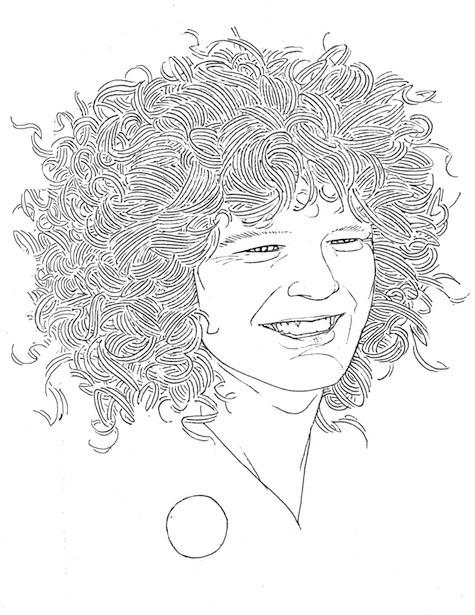Born on this day in 1951, Sally Ride initially pursued tennis seriously, becoming a nationally ranked player before college. She also double majored at Stanford, earning BAs in both English (she loved Shakespeare) and Physics (she also loved lasers). But physics won out, and she earned her PhD in 1978—the same year that she earned a place in NASA’s astronaut program, in an application process that included 1,000 women, and eventually selected six female applicants.
Ride spent much of her time at NASA as part of the team designing the Canadarm. The arm was a potential milestone in space exploration, because if it worked, it could be used to capture satellites and bring them in for repairs. Ride practiced using the arm for hours, before serving as CapCom—capsule commander—for shuttle flights STS-2 and STS-3. Carolyn Huntoon, former director of NASA’s Johnson Space Center, discussed Dr. Ride’s work on the arm, saying “It was designed for pilots, but she was better than the pilots were doing very early on.” On June 18, 1983 she joined the five-person crew aboard the Challenger, becoming the first American woman in space. She also became the first person to use the Canadarm in space for a deployment and retrieval exercise with the Shuttle Pallet Satellite.
Before her mission, she and the other new female astronauts dealt with a barrage of questions about gender. NASA, which is literally made of scientists, asked her about packing tampons for the trip:
“Is 100 the right number?” She would be in space for a week. “That would not be the right number,” she told them.
The tampons were later packed with their strings tied together like sausages, so they wouldn’t float away. Ride was introduced as “the prettiest member of the crew”, and the press asked inane questions, including if going to space made her cry; if the flight would effect her reproductive organs; if she planned to have children. All the women in the program were under constant pressure, not just to be great scientists, but to be role models in a way their hard-drinking Apollo forebears were not. (Fellow astronaut Judy Resnick retaliated by putting a Tom Selleck poster up in the brand-new women’s locker room.) Ride had the additional pressure of keeping her relationships private. During her five year marriage to fellow astronaut Steven Hawley in 1982 (she flew her own plane to the wedding!) the press wanted to tour their home, and even a complimentary profile in People pointed out that she was an “indifferent” housekeeper. (Can’t imagine anyone said that about Jim Lovell.) Dr. Ride also had several relationships with women before her later partnership with professor Tam O’Shaughnessy, and while she may have wanted to keep them private anyway, she didn’t really have the choice to be open if she wanted to continue as an astronaut.
Ride went back into space the following year, and was scheduled for a third flight that was cancelled after the Challenger disaster. She joined the Rogers Commission to investigate the tragedy. As the Commission looked into the explosion they learned that a few engineers with Morton Thiokol, the company that made the fuel boosters used on the Challenger, had warned their superiors about problems that could lead to an explosion. These warnings were ignored. Obviously, the investigation was extremely sensitive, and Ride chose to leak evidence to an Air Force General, Donald J. Kutyna, who was then able to pass the information on to physicist Richard Feynman. Feynman, as a free agent, could then bring the evidence to light without fear of damaging his career, to ensure that life-saving changes were made to future shuttle designs. Possibly even more significant, however, was Ride’s choice to publicly and literally embrace one of those original whistleblowing engineers, Roger Boisjoly. Boisjoly found his career in tatters after the tragedy, and finally left his job with Morton Thiokol. His gratitude to Ride was mentioned in his New York Times obituary:
“He later said he was sustained by a single gesture of support. Sally Ride, the first American woman in space, hugged him after his appearance before the commission. “She was the only one,” he said in a whisper to a Newsday reporter in 1988. “The only one.”
Ride left NASA a few years later, but only after developing the “Ride Report”, a strategy that included launching satellites to monitor climate change on Earth. Years later, on what was actually the 20th anniversary of her first trip into space, Ride gave her time to studying the Columbia disaster in 2003. She was the only person to serve on both investigative committees.
After her time at NASA, Dr. Ride became a professor of physics at UC San Diego, and founded Sally Ride Science, an outreach program that works to get kids, particularly girls, excited about science, while providing K-12 teachers with resources for their science classrooms. She also wrote or co-wrote seven books for children, including To Space and Back, and Mission: Planet Earth: Our World and Its Climate—and How Humans Are Changing Them.
Sally Ride passed away on July 23, 2012 from pancreatic cancer, but her legacy has lived on in a series of honors—the US Navy named a research vessel for her, NASA named a lunar landing area in her honor, and President Obama awarded her the Presidential Medal of Freedom, which was presented to her partner Tam O’Shaughnessy in 2013—but even more importantly, the example she set as a scientist, astronaut, and pioneer will inspire young scientists for years to come.










